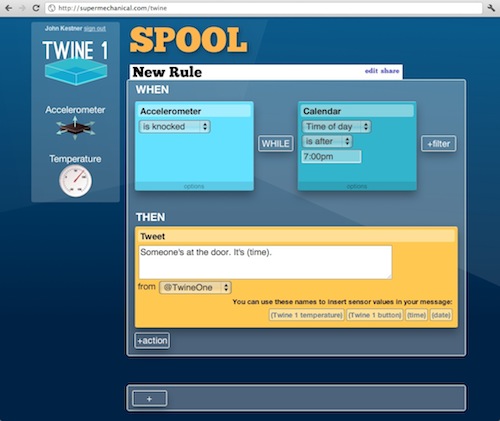Alright, time to announce the winner of our caption contest! First off, thanks for all of you who responded. Over 600 captions made this a tough one to pick. If you didn't win, fret not - there will be another caption contest sometime in January. Plus, there is always Free Day! Anyways, the winner is heyjoe and his caption, "That mohawk makes you look udder'ly ridiculous."

That mohawk makes you look udder'ly ridiculous.
Congrats heyjoe! We'll be in touch to help you claim your prize. Now back to your regularly scheduled programming - check out this cool project from Supermechanical.
What you see in the video above is called "Twine." Twine is a small square enclosure that is WiFi enabled and has a few integrated sensors built in. The beauty of Twine is in its simplicity - using a straight-forward web application, you can program Twine to perform basic "if/then" functions. For example, put the Twine module on your front door and tell it that "if the accelerometer detects a knock, then fire me a text message." In addition to the accelerometer, there is an on-board temperature sensor as well as a port to easily connect other external sensors. They have already built external sensors for moisture and a magnetic switch, as well as a sensor breakout board with endless possibilities. The potential for hacking/tweaking is definitely there.
This a very cool, straight-forward, and polished project. We like it because it really breaks down the barrier to physical computing - yeah, maybe that takes some of the fun out of the "initial discovery" phase, but it certainly will inspire people to create things. It won't be long before people want to explore beyond "knock detection" and start creating their own widgets and projects using Twine. Be sure to check out their Kickstarter page if you'd like to make a contribution and/or get your own Twine. Very nice work!







Has anyone else noticed that the Comments bar always says that there is one more comment than there actually is?
It's because a comment was deleted for one reason or other. The top count is the number of visible, the bottom one is the total. The reason the bottom one is left the way it is has to do with code efficiency, unfortunately. For the current implementation, it's too expensive to have it display the "accurate" count.
Ah. Thanks!
What I want to know is how do you change the batteries? It appears that they are molded into the case.
Too bad only people in the USA can use Kickstarter for their projects.
There is another for Europe, but I can't remember the name of it.
EDIT Found it, http://www.crowdfunder.co.uk/
Too bad only people in USA and Europe can use this sites for their projects...
How do we get our Kickstarter project on the SparkFun home page?
The best way is to submit your project to our project call. This in itself is no guarantee it will end up on our homepage, but it'll put your project on our radar. We dip into this pool regularly for project features.
But we can't promise anything will for sure find it's way to our homepage. If you have a great project and documentation, it'll help the chances of your project ending up on the page.
WOW this is awesome I wish I had ideas like that...
The thing I really like about this project is that anyone could have an idea like this - it really is a fairly simple idea. What Supermechanical did was do a fantastic job of packaging up a simple idea in a user-friendly way. We've said this before, it's not about how complicated the technology is - but how you apply it.
You probably have a million dollar idea rattling around in your head and you don't even know it!
Is their work open hardware? I would like to see if they designed wifi-complaint hardware, or if they just dropped in a module.
I know it's ridiculously difficult, but how cool would it be to see people designing wifi-compliant hardware?
Wifi-Complaint? I have some complaints about the Wifi in our house... ;)
I swear I saw a project almost exactly like this a few years ago. Maybe the precursor to Twine? I like it though. Like mentioned, it's a good way to get into physical computing.